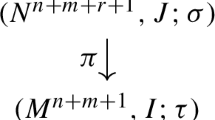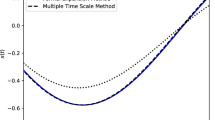Abstract
In this paper we characterize the solvability of nonlinear decoupling problems (static or dynamic) through the notion of structure at infinity. This structure is specified by a list of easily computed integers, which are related to the differential output rank. Our notion of structure at infinity generalizes concepts previously introduced for restricted classes of systems such as those linearizable under feedback.
Similar content being viewed by others
References
M. D. di Benedetto, On the equivalence of the invariant subdistribution algorithm and the structure algorithm,Systems Control Lett.,8 (1986), 137–145.
C. Commault and J. M. Dion, Structure at infinity of linear multivariable systems: a geometric approach,IEEE Trans. Automat. Control,27 (1982), 693–696.
C. Commault, J. Descusse, J. M. Dion, J. F. Lafay, and M. Malabre, About new decoupling invariants: the essential orders,Internat. J. Control,44 (1986), 689–700.
G. Conte, C. H. Moog, and A. M. Perdon, Un Théorème sur la Représentation Entrée-Sortie d’un Système Non Linéaire, preprint, 1987.
J. Descusse and J. M. Dion, On the structure at infinity of linear square decoupled systems,IEEE Trans. Automat. Control,27 (1982), 971–974.
J. Descusse and C. H. Moog, Decoupling with dynamic compensation for strong invertible affine nonlinear systems,Internat. J. Control,42 (1985), 1387–1398.
J. Descusse and C. H. Moog, Dynamic decoupling for right-invertible nonlinear systems,Systems Control Lett.,8 (1987), 345–349.
M. Fliess, A new approach to the noninteracting control problem in nonlinear systems theory,Proceedings of the 23rd Allerton Conference, Monticello, IL, 1985, pp. 123–129.
M. Fliess, A new approach to the structure at infinity of nonlinear systems,Systems Control Lett.,7 (1986), 419–421.
M. Fliess, A note on the invertibility of nonlinear input-output differential systems,Systems Control Lett.,8 (1986), 147–151.
R. M. Hirschorn, Invertibility of multivariable nonlinear control systems,IEEE Trans. Automat. Control,24 (1979), 855–865.
A. Isidori, Nonlinear feedback, structure at infinity and the input-output linearization problem, inProceedings of MTNS 83, Beer Sheva (P. A. Fuhrmann, ed.), pp. 473–493, Lecture Notes in Control and Information Sciences, Vol. 58, Springer-Verlag, Berlin, 1984.
A. Isidori, Control of nonlinear systems via dynamic state-feedback, inAlgebraic and Geometric Methods in Nonlinear Control Theory (Proc. Conf., Paris, 1985) (M. Fliess and M. Hazewinkel, eds.), pp. 121–145, Reidel, Dordrecht, 1986.
A. Isidori and C. H. Moog, On the nonlinear equivalent of the notion of transmission zeros, inModelling and Adaptive Control (Proc. I.I.A.S.A. Conf., Sopron, 1986) (C. I. Byrnes and A. Kurszanski, eds.), Lecture Notes in Control and Information Sciences, Springer-Verlag, Berlin (to appear).
A. Isidori, C. H. Moog, and A. de Luca, A sufficient condition for full linearization via dynamic state-feedback,Proceedings of the 25th CDC, Athens 1986, pp. 203–208.
M. Malabre,Structure à l’Infini des Triplets Invariants—Application à la Poursuite Parfaite de Modèle pp. 43–53, Lecture Notes in Control and Information Sciences, Vol. 44, Springer-Verlag, Berlin, 1982.
M. Malabre, A complement about the structure of linear systems,Systems Control Lett.,4 (1984), 339–342.
C. H. Moog, Inversion, Découplage et Poursuite de Modèle des Systèmes Non Linéaires, Thèse d’Etat, University of Nantes, 1987.
H. Nijmeijer and W. Respondek, Decoupling via dynamic compensation for nonlinear control systems,Proceedings of the 25th CDC, Athens 1986, pp. 192–197.
H. Nijmeijer and W. Respondek, Dynamic Input-Output Decoupling of Nonlinear Control Systems, Memo No. 575, Technical University, Twente, 1986.
H. Nijmeijer and J. M. Schumacher, Zeros at infinity for affine nonlinear control systems,IEEE Trans. Automat. Control,30 (1985), 566–573.
L. M. Silverman, Inversion of multivariable linear systems,IEEE Trans. Automat. Control,14 (1969), 270–276.
L. M. Silverman and A. Kitapçi, System structure at infinity,Systems Control Lett.,3 (1983), 123–131.
S. N. Singh, A modified algorithm for invertibility in nonlinear systems,IEEE Trans. Automat. Control,26 (1981), 595–598.
A. I. G. Vardulakis, On infinite zeros,Internat. J. Control,32 (1980), 849–866.
A. I. G. Vardulakis, D. J. N. Limebeer, and N. Karcanias, Structure and Smith MacMillan form of a rational matrix at infinity,Internat. J. Control,35 (1982), 701–725.
Author information
Authors and Affiliations
Rights and permissions
About this article
Cite this article
Moog, C.H. Nonlinear decoupling and structure at infinity. Math. Control Signal Systems 1, 257–268 (1988). https://doi.org/10.1007/BF02551287
Received:
Revised:
Issue Date:
DOI: https://doi.org/10.1007/BF02551287




